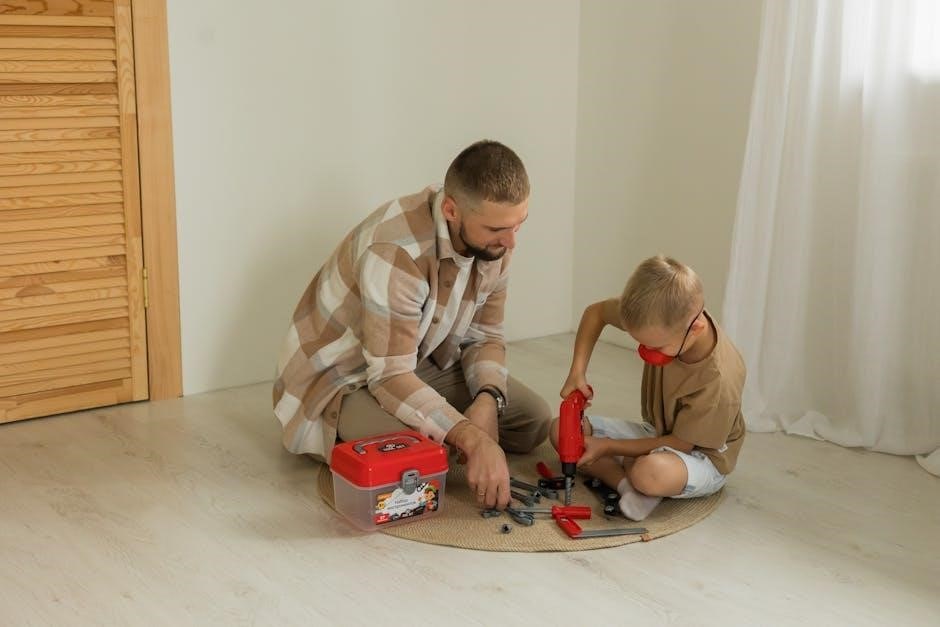poly compatibility guide

Polyamory‚ the practice of consensual non-monogamy‚ involves navigating multiple romantic relationships with transparency and respect․ Compatibility is key to fostering harmony‚ trust‚ and emotional fulfillment in these dynamics․
1․1 What is Polyamory?
Polyamory‚ often referred to as ethical non-monogamy‚ is the practice of engaging in multiple consensual romantic or sexual relationships simultaneously․ It emphasizes open communication‚ mutual respect‚ and consent among all parties involved․ Unlike traditional monogamy‚ polyamory allows individuals to form emotional and intimate connections with multiple partners‚ fostering a network of relationships often described as a “polycule․” This lifestyle prioritizes honesty‚ trust‚ and the emotional well-being of everyone involved‚ ensuring that all partners feel valued and respected in their unique roles within the dynamic․
1․2 Why Compatibility Matters in Polyamory
Compatibility is crucial in polyamory as it fosters harmony‚ trust‚ and emotional fulfillment among all partners․ Shared values‚ lifestyle alignment‚ and communication styles significantly impact relationship dynamics․ When partners are compatible‚ conflicts and jealousy are minimized‚ creating a stable foundation for intimacy․ Compatibility ensures that each individual’s needs and boundaries are respected‚ allowing relationships to thrive․ It also promotes mutual understanding and empathy‚ essential for navigating the complexities of multiple partnerships․ Ultimately‚ compatibility is key to building and maintaining healthy‚ balanced polyamorous relationships․
Types of Polyamory
Polyamory encompasses various structures‚ including hierarchical and non-hierarchical relationships‚ triads‚ quads‚ polycules‚ solo polyamory‚ and relationship anarchy‚ each offering unique dynamics for compatibility and connection․
2․1 Hierarchical vs․ Non-Hierarchical Polyamory
In hierarchical polyamory‚ relationships are prioritized‚ with a “primary” partner often receiving more attention and commitment․ This structure can create clear boundaries but may lead to jealousy․ Non-hierarchical polyamory‚ in contrast‚ emphasizes equality among all relationships‚ avoiding labels like “primary” or “secondary․” This approach fosters a more fluid dynamic but requires careful communication to ensure all partners feel valued․ Both models require compatibility in expectations and boundaries to maintain harmony and emotional balance across all relationships․
2․2 Triads‚ Quads‚ and Polycules
A triad involves three people in a romantic relationship‚ while a quad includes four․ Polycules are larger networks where individuals are connected through shared partners․ These structures require strong compatibility‚ as each person’s needs and boundaries must align․ Shared values‚ open communication‚ and mutual respect are essential for harmony․ Compatibility in these dynamics ensures emotional fulfillment and avoids conflicts‚ fostering a supportive and inclusive environment for all involved․
2․3 Solo Polyamory and Relationship Anarchy
Solo polyamory involves individuals who embrace multiple relationships without a primary partner‚ prioritizing autonomy and self-sufficiency․ Relationship anarchy rejects traditional hierarchies‚ emphasizing fluid‚ non-hierarchical connections․ Both approaches require compatibility rooted in mutual respect and clear communication․ They thrive on personal freedom‚ flexibility‚ and the absence of rigid structures․ These models highlight the importance of aligning values and boundaries while fostering independence and emotional fulfillment for all parties involved․
Understanding Compatibility in Polyamory
Compatibility in polyamory hinges on shared values‚ sexual alignment‚ and emotional resonance․ It ensures harmony‚ trust‚ and mutual growth‚ forming the foundation for thriving relationships․
3․1 Shared Values and Lifestyle
Shared values and lifestyle alignment are crucial for polyamory success․ Compatible partners often hold similar views on honesty‚ communication‚ and boundaries․ A matching lifestyle ensures smoother integration of relationships‚ reducing conflicts․ For instance‚ if all parties value transparency and open dialogue‚ trust is easier to build․ Additionally‚ shared interests and life goals create a stronger bond‚ fostering a supportive environment․ When values align‚ navigating polyamory’s challenges becomes more manageable‚ leading to healthier and more fulfilling connections․
3․2 Sexual Compatibility and Preferences
Sexual compatibility plays a significant role in polyamorous relationships‚ ensuring mutual satisfaction and emotional connection․ Open communication about desires‚ boundaries‚ and preferences is essential to align expectations․ Compatible sexual interests help prevent misunderstandings and foster intimacy․ While differences can be navigated‚ shared preferences often strengthen bonds․ Prioritizing consent and respect ensures all partners feel valued‚ creating a foundation for healthy and fulfilling connections․ Sexual compatibility‚ when addressed thoughtfully‚ enhances trust and harmony within polyamorous dynamics․
3․3 Emotional and Intellectual Connection
An emotional and intellectual connection is vital for compatibility in polyamorous relationships․ Shared values‚ interests‚ and communication styles foster deeper bonds․ Emotional alignment ensures partners can support each other’s needs‚ while intellectual compatibility stimulates engaging interactions․ Trust and mutual respect are foundational‚ allowing relationships to thrive․ When partners connect on these levels‚ they create a resilient and fulfilling dynamic‚ enhancing overall compatibility and relationship satisfaction․
The Role of Communication in Polyamory
Effective communication is the cornerstone of polyamory‚ ensuring open dialogue‚ active listening‚ and conflict resolution strategies are prioritized to maintain trust and harmony among all partners․
4․1 Open and Honest Dialogue
Open and honest dialogue is essential in polyamory‚ fostering trust and understanding․ Regular discussions about feelings‚ boundaries‚ and expectations ensure all partners feel heard and respected․ This transparency helps prevent misunderstandings and strengthens emotional bonds․ By creating a safe space for vulnerability‚ partners can address concerns early‚ promoting harmony and mutual respect․ Honest communication also allows for the exploration of compatibility‚ ensuring that all relationships within the polycule align with shared values and goals․
4․2 Active Listening and Empathy
Active listening and empathy are vital in polyamory‚ ensuring each partner feels valued and understood․ By fully engaging with others’ emotions and perspectives‚ misunderstandings are minimized․ Empathy fosters a supportive environment‚ allowing partners to express vulnerabilities openly․ This deep emotional connection strengthens bonds and builds trust‚ essential for navigating the complexities of multiple relationships․ Prioritizing empathy ensures that all voices are heard‚ creating a foundation of mutual respect and understanding within the polycule․
4․3 Conflict Resolution Strategies
Effective conflict resolution in polyamory requires calm communication‚ active listening‚ and a focus on solutions rather than blame․ Addressing disagreements promptly prevents escalation‚ while remaining empathetic ensures emotional safety․ Open dialogue helps clarify needs and boundaries‚ fostering mutual understanding․ Seeking compromise and respecting each partner’s perspective strengthens trust and harmony․ Regular check-ins and agreed-upon strategies can preempt conflicts‚ ensuring relationships remain resilient and fulfilling for all involved․
Finding Compatible Partners
Finding compatible partners in polyamory involves open communication‚ shared values‚ and mutual respect․ Online platforms‚ social events‚ and honest dialogue help gauge compatibility and build connections effectively․
5․1 Online Platforms for Polyamory
Online platforms like Feeld‚ OkCupid‚ and FetLife cater to polyamorous individuals‚ offering spaces to connect with like-minded people․ These sites allow users to specify their relationship status and preferences‚ making it easier to find compatible partners․ Features such as interest-based groups and forums foster community building and open dialogue․ By leveraging these tools‚ individuals can navigate the polyamorous dating scene with greater ease and confidence‚ ensuring alignment with potential partners’ values and lifestyles․
5․2 Attending Polyamory Events
Attending polyamory events‚ such as workshops‚ meetups‚ and conferences‚ provides opportunities to connect with like-minded individuals․ These gatherings foster open dialogue‚ allowing participants to assess compatibility and build relationships in a supportive environment․ Events often feature discussions on polyamory dynamics‚ boundaries‚ and communication strategies‚ helping attendees navigate the complexities of non-monogamous relationships․ Engaging in these communities can enhance understanding and facilitate meaningful connections‚ making it easier to find partners who align with your values and lifestyle․
5․3 Assessing Compatibility in Initial Meetings
Assessing compatibility in initial meetings involves open communication about values‚ boundaries‚ and expectations․ Ask questions to understand each person’s lifestyle‚ beliefs‚ and relationship goals․ Observe how they express their needs and handle discussions about boundaries․ Compatibility is not just about attraction but also about emotional alignment and mutual respect․ Pay attention to how they interact with others and whether their approach to polyamory aligns with yours․ Transparency and honesty are key to evaluating potential matches effectively․
Building and Maintaining Polyamorous Relationships
Building and maintaining polyamorous relationships requires trust‚ open dialogue‚ and clear boundaries․ Emotional alignment and active listening foster deeper connections‚ ensuring harmony among all partners involved․
6․1 Setting Boundaries and Agreements
Establishing clear boundaries and agreements is crucial in polyamorous relationships․ These guidelines ensure mutual respect‚ trust‚ and emotional safety․ Boundaries may include physical‚ emotional‚ or sexual limits‚ while agreements outline expectations for communication‚ time management‚ and conflict resolution․ Regular discussions and written agreements can help prevent misunderstandings․ It’s important to revisit and adjust boundaries as relationships evolve‚ ensuring all parties feel heard and respected․ Open dialogue fosters trust‚ while respecting each partner’s needs maintains harmony in the dynamic․
6․2 Navigating Jealousy and Insecurity
Jealousy and insecurity can arise in polyamorous relationships‚ often stemming from fear or uncertainty․ Addressing these feelings requires open communication‚ empathy‚ and trust․ Acknowledge emotions without judgment‚ and foster a supportive environment where partners feel safe expressing concerns․ Regular check-ins and reassurance can help alleviate insecurities․ Trust-building activities‚ such as transparency and reliability‚ strengthen connections․ Encouraging personal growth and self-reflection also empowers individuals to manage their emotions healthily․ By addressing jealousy early and constructively‚ relationships can grow stronger and more resilient․
6․3 Time Management and Prioritization
Effective time management is crucial in polyamorous relationships to ensure quality interactions with all partners․ Create a schedule that balances individual needs‚ shared activities‚ and personal time; Prioritize open communication to align expectations and avoid conflicts․ Regular check-ins help maintain connection and address any feelings of neglect․ Self-care is essential to prevent burnout‚ as juggling multiple relationships can be emotionally taxing․ By organizing time thoughtfully‚ you foster a sense of security and satisfaction for everyone involved‚ ensuring harmony and fulfillment in the relationship dynamic․

Navigating Challenges in Polyamory
Navigating polyamory involves addressing jealousy‚ time management‚ and societal stigma․ Open dialogue‚ empathy‚ and mutual respect are essential to overcome these challenges and foster healthy‚ fulfilling relationships․
7․1 Managing Multiple Relationships
Managing multiple relationships in polyamory requires balancing time‚ emotions‚ and commitments․ Open communication‚ scheduling‚ and prioritizing quality interactions with each partner are crucial․ Emotional and logistical challenges arise‚ but with empathy and organization‚ harmony can be maintained․ Regular check-ins and respecting boundaries help ensure all partners feel valued and secure․ Time management strategies‚ like shared calendars‚ can prevent burnout and foster a sense of fairness; Consistent effort and adaptability are key to sustaining healthy‚ fulfilling connections․
7․2 Dealing with Societal Stigma
Polyamory often faces societal judgment due to misunderstandings or traditional norms․ Many experience stigma‚ impacting mental health and relationships․ Surrounding yourself with supportive communities and educating others can help․ Resilience is key‚ as societal acceptance grows slowly․ Embracing your choices and seeking understanding from loved ones fosters strength․ Remember‚ polyamory’s validity isn’t diminished by external opinions․ Living authentically‚ despite stigma‚ is crucial for personal and relational well-being․
7․3 Balancing Independence and Interdependence
In polyamorous relationships‚ balancing independence and interdependence is crucial․ Each partner must maintain personal autonomy while nurturing connections․ Time management and open communication help ensure individual needs are met alongside shared responsibilities․ Respecting personal space fosters healthy interdependence‚ preventing codependency․ Trust and mutual respect are foundational‚ allowing partners to thrive both individually and collectively․ This balance strengthens emotional bonds and promotes a fulfilling‚ harmonious polyamorous dynamic․
The Importance of Boundaries
Boundaries are essential in polyamory to ensure respect‚ trust‚ and emotional well-being․ They prevent conflicts and emotional turmoil‚ fostering a healthy environment for all partners to thrive mutually․
8․1 Physical and Emotional Boundaries
Establishing clear physical and emotional boundaries is crucial in polyamorous relationships․ These boundaries ensure personal space and emotional well-being‚ preventing feelings of overwhelm or neglect․ They also foster trust and respect among all partners․ By defining what is and isn’t acceptable‚ individuals can maintain their autonomy while nurturing their connections․ Regular communication helps in revisiting and adjusting these boundaries‚ ensuring they remain fair and effective for everyone involved in the relationship dynamic․
8․2 Respecting Personal Space
Respecting personal space in polyamorous relationships is vital for maintaining emotional well-being and fostering trust․ Each partner deserves time for self-reflection and individual growth‚ ensuring they don’t feel overwhelmed․ Scheduling alone time or setting physical boundaries can help preserve autonomy․ Open communication about needs ensures everyone’s comfort and harmony․ Respecting personal space strengthens the foundation of polyamorous dynamics‚ allowing relationships to thrive without compromising individuality or emotional balance․

8․3 Revisiting and Adjusting Boundaries
Boundaries in polyamorous relationships are not static; they evolve as needs and circumstances change․ Regularly revisiting and adjusting boundaries ensures they remain relevant and respectful of all partners․ Open dialogue about shifting desires‚ comfort levels‚ or life changes is essential․ Flexibility and willingness to adapt foster trust and harmony․ Adjustments should be made collaboratively‚ prioritizing mutual respect and emotional well-being․ This process strengthens relationships and ensures compatibility remains a foundation of the polyamorous dynamic․

Time Management Strategies
Effective time management in polyamory involves scheduling‚ organization‚ and balancing quality time with each partner․ Prioritizing commitments ensures satisfaction and avoids burnout‚ maintaining emotional well-being․
9․1 Scheduling and Organization
Scheduling and organization are vital for managing multiple relationships effectively․ Using shared calendars or planners helps track commitments and ensure quality time with each partner․ Balancing individual needs with collective priorities fosters harmony․ Regular check-ins and flexible adjustments maintain equilibrium‚ preventing overwhelm․ Open communication about availability and boundaries is essential․ By prioritizing organization‚ polyamorous individuals can nurture meaningful connections without sacrificing personal time or emotional well-being․
9․2 Quality Time with Each Partner
Quality time with each partner is essential for fostering emotional connections and preventing feelings of neglect․ Plan regular‚ meaningful activities tailored to each partner’s interests to ensure they feel valued․ Whether it’s a quiet evening or an adventurous outing‚ prioritize undivided attention to strengthen bonds․ Consistent effort in spending quality time reinforces trust and intimacy‚ ensuring all relationships thrive in a polyamorous dynamic․
9․3 Avoiding Burnout
Avoiding burnout in polyamorous relationships requires balancing time‚ energy‚ and emotional resources․ Set realistic expectations and prioritize self-care to prevent overwhelm․ Use scheduling tools to manage commitments‚ ensuring adequate rest and personal time․ Delegate tasks when possible and communicate openly with partners about your limits․ Regularly assess your capacity to avoid overextension․ Remember‚ rest and boundaries are essential for maintaining healthy‚ sustainable relationships․ By prioritizing your well-being‚ you can nurture connections without sacrificing your own needs․

The Role of Empathy in Polyamory
Empathy is crucial in polyamory‚ fostering understanding and emotional support among partners․ It strengthens connections‚ builds trust‚ and helps navigate complexities‚ ensuring harmonious and fulfilling relationships․
10․1 Understanding Each Partner’s Needs

Understanding each partner’s needs is vital in polyamory‚ ensuring emotional and physical fulfillment․ Open communication helps identify preferences‚ boundaries‚ and expectations‚ fostering trust and harmony․ Recognizing individual desires allows for tailored approaches‚ preventing misunderstandings and enhancing intimacy․ By actively listening and empathizing‚ partners can create a supportive environment where everyone feels valued and heard․ This foundation of mutual understanding is essential for maintaining healthy‚ compatible relationships in a polyamorous dynamic․
10․2 Emotional Support and Validation
Emotional support and validation are crucial in polyamory‚ ensuring each partner feels secure and valued․ Active listening and empathy help address feelings of jealousy or insecurity‚ fostering trust․ Validating emotions acknowledges each partner’s experiences‚ strengthening bonds․ Open dialogue creates a safe space for expression‚ preventing resentment․ By prioritizing emotional well-being‚ partners can navigate challenges together‚ building a stable and loving environment․ This mutual support is essential for maintaining harmony and compatibility in polyamorous relationships․

10․3 Fostering a Supportive Environment
Fostering a supportive environment in polyamory involves creating a space where trust‚ empathy‚ and mutual respect thrive․ Encouraging open communication and active listening helps partners feel heard and valued․ Shared values and boundaries are essential for building a foundation of understanding․ By promoting emotional safety‚ individuals can express their needs and desires without fear of judgment․ This supportive framework allows relationships to grow‚ ensuring each partner feels cherished and integral to the dynamic․ A nurturing environment is key to long-term harmony and compatibility in polyamorous connections․

Expert Advice and Resources

Seek expert advice through books like The Ethical Slut and online communities․ Professional counseling can also provide tailored guidance for navigating polyamorous relationships effectively․
11․1 Recommended Books on Polyamory
Books like The Ethical Slut by Dossie Easton and Janet Hardy offer practical insights into ethical non-monogamy․ More Than Two by Franklin Veaux and Eve Rickert provides guidance on navigating polyamorous relationships․ Opening Up by Tristan Taormino explores communication and boundaries․ These resources are invaluable for understanding poly compatibility‚ addressing emotional challenges‚ and building healthy‚ consensual relationships․ They provide real-life examples and strategies for fostering trust and harmony in polyamorous dynamics․
11․2 Online Communities and Forums
Online communities like Reddit’s r/polyamory‚ FetLife‚ and polyamory-focused Facebook groups provide valuable spaces for discussion and connection․ These forums allow individuals to share experiences‚ seek advice‚ and learn about poly compatibility․ They offer resources for navigating relationships‚ understanding boundaries‚ and addressing challenges․ Engaging with these communities can foster personal growth and provide practical insights into building harmonious polyamorous connections․ They are essential for those exploring or deepening their understanding of polyamory and its diverse dynamics․
11․3 Professional Counseling for Polyamorous Relationships
Professional counseling tailored for polyamorous relationships can provide guidance on navigating complex dynamics‚ addressing jealousy‚ and improving communication․ Therapists experienced in polyamory help partners explore compatibility‚ set boundaries‚ and resolve conflicts․ They offer strategies to maintain emotional balance and foster trust․ Counseling can also assist in understanding each partner’s needs and preferences‚ ensuring a harmonious and fulfilling polyamorous experience․ Seeking professional advice is a proactive step toward building and sustaining healthy‚ compatible relationships in a non-traditional setup․
Polyamory thrives on compatibility‚ communication‚ and mutual respect․ By understanding each partner’s needs and boundaries‚ individuals can build fulfilling relationships rooted in trust and emotional intelligence․
12․1 Final Thoughts on Poly Compatibility
Poly compatibility is the cornerstone of successful polyamorous relationships‚ requiring trust‚ communication‚ and emotional intelligence․ Shared values‚ lifestyle alignment‚ and sexual preferences lay the groundwork for harmony․ Compatibility isn’t static; it evolves‚ demanding ongoing effort to navigate challenges like jealousy and societal stigma․ By fostering empathy and respect‚ individuals can build resilient connections․ Compatibility guides the journey‚ ensuring all partners thrive․ It’s a dynamic process that‚ when prioritized‚ leads to fulfilling and enduring relationships․

12;2 Encouragement for Further Exploration
Polyamory offers a transformative journey of self-discovery and connection․ Embrace curiosity and openness to explore its possibilities․ Seek resources like books‚ online communities‚ and workshops to deepen understanding․ Success in polyamory stems from empathy‚ communication‚ and a willingness to grow․ For those intrigued‚ take the first step by engaging with the polyamorous community․ Remember‚ compatibility is a dynamic process that evolves with effort and dedication․ Open your heart to the potential of loving abundantly and fostering meaningful connections․



Leave a Reply
You must be logged in to post a comment.